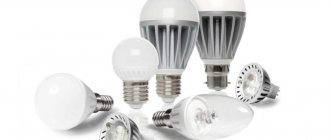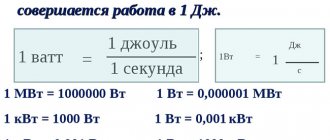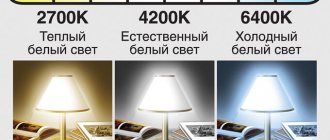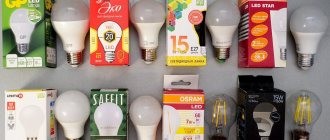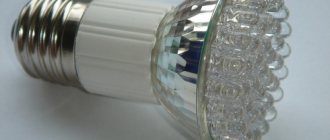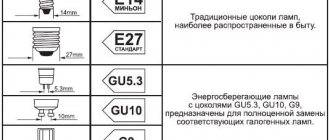The massive replacement of incandescent lamps with LED lamps is due to the economic benefits of such a solution. Light Emitting Diodes (LED) provide high luminous efficiency (up to 150 lm/W) with significantly lower power consumption. The watts of incandescent and LED lamps differ greatly: for incandescent lamps it is 40 W, 60 W, 100 W, and for LED lamps it is 7 W, 9 W, 15 W, and it can be difficult to figure out what the correct ratio is between them.
We will tell you how to choose an LED lamp by power - after reading the article, the conversion will become clear to you, and you will be able to independently calculate what power of an LED lamp is suitable for a cafe, cottage, office, industrial or administrative building.
Simple calculation of the required luminous flux power of LED lamps
In this article we look at replacing incandescent lamps with E27 and E14 sockets. Conversion formula: to simply calculate the required power of an LED lamp, you need to divide the power of the incandescent lamp by 6.5.
That is, to replace a 60 W incandescent lamp with LED power, it can be calculated using the formula: 60/6.5=9. We need a 9 W LED lamp. And some manufacturers of high-quality lamps have enough 7 W.
There is an error in this formula, but as a first approximation it will give you approximate information about how much power LED light bulb you need. After reading the article to the end, you will understand what this error is associated with and why any recalculation will be approximate. 1. Luminous flux power - measured in lumens (Lm). This value indicates how bright the light bulb is. 2. Power consumption - measured in watts (W). This value means how much electricity the light bulb consumes from the network.
When replacing incandescent light bulbs with LED ones, a lamp with approximately the same luminous flux power (in lumens, Lm) is selected so that the illumination level does not deteriorate after replacement. And the electrical power consumed from the outlet (in watts, W) will become several times lower.
Factors due to which the recalculation will be inaccurate: 1. The luminous flux power of incandescent and LED lamp models with similar characteristics always differs from each other, up or down. 2. The luminous power or luminous flux indicated in the characteristics of LED lamps are correct only for high-quality bulbs. For cheap, low-quality products, these figures are far from reality.
Colorful temperature
Possible indicators:
- From 2700 to 3000K;
- 4000K;
- 6500K.
This concept is also one of the characteristics of diode lamps. It is measured in Kelvin (K). The color of the glow depends on this indicator. For example, a color temperature value between 2700K and 3000K indicates that the light will be yellowish.
Lamps with a color temperature of 4000K have a white glow. This type of light is usually used in shopping centers. And if the indicator is 6500K, then the light will be cold white. Such lamps are used only in industrial premises.
For the home, lamps with a color temperature level of 2700K – 3000K are best suited.
Ratio of luminous power in watts of incandescent and LED lamps
A simple method for converting the power of LED lamps to incandescent lamps when replacing looks like this:
1. Find its luminous flux power in the technical characteristics of the old incandescent lamp. For example, for a 60 W incandescent light bulb it is 615 lm (the value may vary among different manufacturers).
2. View the luminous flux power of LED lamp models with a suitable E27 or E14 socket (luminous flux indicators may also differ between light bulbs from different manufacturers).
- A 7 W LED lamp has a luminous flux of 600 lm.
- Power 9 W – 720 lm.
- Power 10 W – 750 lm.
3. Select an LED lamp with a luminous flux power close to the required one. In this case, with some reserve, LED light bulbs with a power consumption of 8 W or 9 W are suitable for us.
Let's consider recalculation for other most common lamp powers.
A 100 W incandescent lamp has a luminous flux of 1360 lm. The nearest options for LED lamps:
- A 15 W LED bulb has a luminous flux of 1350 lm.
- A 20 W LED bulb has a luminous flux power of 1600 lm.
As a result, a 15 W LED bulb will be suitable to replace a 100 W incandescent lamp.
If we consider the correspondence in terms of luminous flux from LED lamps, we get:
- A 7 watt LED bulb is equivalent to a 40 watt incandescent bulb.
- A 10W LED bulb is equivalent to a 60W incandescent bulb (but produces a higher lumen output of 750 lumens versus 615 lumens for an incandescent bulb).
- A 15 watt LED bulb is equivalent to a 100 watt incandescent bulb.
For ease of selection, all options are summarized in a table that corresponds to the power of LED lamps compared to incandescent lamps.
Types of diode light bulbs
The first criterion for dividing is the material of the case:
- Glass (frosted or transparent);
- Aluminum;
- Plastic;
- Ceramics.
By type of base:
- Screw (letter designation – E);
- Pin (letter designation - G).
On the base, in addition to the letter indicating its type, numbers are indicated that indicate for the first type the diameter, measured in millimeters, and for the second type this is the length between the pins.
Thus, the following types of LEDs can be distinguished:
- E14 (bulbs with a smaller diameter base, suitable for some lamps);
- E27 (regular, which are suitable for installation, for example, in chandeliers, where the socket is designed for incandescent light bulbs);
- G4 (can be used, for example, to illuminate pictures).
- GU5.3, G9 (replacement for halogen bulbs);
- GU10 (used for built-in lamps that serve as lighting, as well as in hoods);
This list shows only the main types.
Table of correspondence between the power of LED lamps and incandescent lamps
| № | Incandescent lamps | LED bulbs | ||
| Power consumption (W) | Luminous flux power (lm) | Power consumption (W) | Luminous flux power (lm) | |
| 1 | 25 | 300 | 360 | 4 |
| 2 | 40 | 580 | 600 | 7 |
| 3 | 60 | 615 | 720 | 9 |
| 4 | 75 | 935 | 990 | 11 |
| 5 | 95 | 1250 | 1150 | 13 |
| 6 | 100 | 1360 | 1350 | 15 |
| 7 | 150 | 2150 | 2700 | 30 |
| 8 | 200 | 2950 | 4700 | 50 |
The table shows the luminous flux power indicators of lamps presented in the retail network. It is recommended to clarify these indicators according to the technical characteristics of the manufacturer of the lamps you are using or intend to buy.
Let's look at a couple of examples of selecting the power of LED lamps using this table.
A 75 W incandescent lamp provides a luminous flux of 935 lm. According to the table, the closest in brightness will be an 11 W LED lamp, giving a luminous flux of 990 lm. To select a replacement for a 100 W incandescent lamp, we determine its luminous flux: it is equal to 1360 lm. We are looking for an LED lamp with a similar luminous flux power: an LED lamp producing a luminous flux of 1350 lm has a power consumption of 15 W.
Efficiency
Efficiency should also be taken into account when choosing products. Efficiency shows how much electricity is converted into light and how much into thermal energy (which is actually what causes the bulb to heat up). LED lamps have an efficiency of about 90%, which is a very high figure compared to the alternative, in which only 7-9% of electricity is converted into light.
Luminous output and differences in the operating principle of incandescent and LED lamps
As you can see, incandescent lamps at similar brightness, that is, luminous flux power, consume more energy. The ratio of power consumption to luminous flux power is called luminous efficiency, which is measured in W/lm (watts per lumen).
Luminous efficiency is an indicator of the efficiency of lamps, indicating how many watts of electrical power need to be spent to obtain a unit of brightness of its glow. A 60 W incandescent lamp has a luminous efficiency of 10 W/lm. Its analogue, a 9 W LED lamp, has a luminous efficiency of 80 W/lm. As you can see, the luminous efficiency of incandescent lamps is several times less than the luminous efficiency of LED lamps. This LED lamp is 8 times more economical than an incandescent lamp.
Why is there such a difference? This is due to the differences in the operating principle of incandescent lamps and LED lamps.
| The glow of incandescent lamps is caused by a hot filament in a vacuum in a glass bulb. Heat is the cause of large energy losses in incandescent lamps. | The glow of LED lamps occurs due to photoemission, the optical emission of LEDs when current is passed through. LEDs heat up much less, and they also have less energy loss. |
Recommendations for selection
To replace uneconomical incandescent elements with diode devices, it is necessary to determine the base of the desired device. To do this, you need to measure the depth and diameter of the cartridge. Next, you must follow the following recommendations:
- There is no need to rely on the power of the device being replaced. Use the auxiliary correspondence table above.
- Luminous flux is an equally important nuance when selecting a lighting device. It is necessary to compare the luminous flux value of devices with the same operating angle.
- Scattering angle. To illuminate the entire room, a light source with an illumination angle of 170°C will be sufficient. This option allows you to illuminate the floor and walls, while leaving the ceiling dark. For wall-mounted or table-top products, it is better to use lighting equipment with a small radius of illumination.
Power vs luminous flux graph
- Temperature of light. You should know that the temperature regime must correspond to the purpose of the room:
- at a temperature of 4000-5000°K, daylight awakens alertness, is conducive to work, does not blind the eyes, and is used in offices;
- 2500-3500°K – warm light has a beneficial effect on the comfort of psychological relaxation, used in the bedroom, living room, etc.
With all the variety of light elements, the vast majority of them are produced with a screw-type base - an Edison screw. And among the first places are shared, respectively, by E14 and E27, which operate on a 220V network. In this marking, E means type (Edison Screw), and the digital combination means the diameter of the base (the width of the cartridge).
Why do you need to replace incandescent lamps with LEDs?
The main reasons why incandescent lamps are replaced with LED ones:
- energy savings: LED lamps consume several times less electricity than incandescent lamps.
- service life and replacement frequency: LED lamps have a much longer service life, and they can be changed less often: - incandescent light bulbs - up to 1000 hours, - LED light bulbs - 20,000-50,000 hours.
Lamp life may vary among individual manufacturers depending on the quality of components used and manufacturing.
The advantages and disadvantages of LED lighting are discussed in more detail in this article. We hope that from this article you learned how to calculate the power of LED lamps when replacing incandescent lamps. If you have any questions about choosing or using LED lamps, call: +7.
Pros and cons of purchasing this type of light bulbs
Positive and negative aspects can be assessed using the following indicators:
- Price;
- Dimensions;
- Directional light;
- Ripple.
As for the first characteristic, we can say that the cost can be twice as much as for a regular light bulb. This is the main disadvantage of the product. However, it is worth considering that due to energy savings, the cost of the product will pay for itself.
When replacing a light bulb, you need to consider its size. LED dimensions may be larger compared to conventional ones. This may affect the appearance; the light bulb may stick out strongly from the lamp or may not fit there at all.
LED bulbs have a slightly different direction of light, which may be unusual at first. Their side lighting is poor.
The positive thing is that there is no light pulsation. However, not all light bulbs have this phenomenon. You need to purchase a quality product to avoid pulsation that is unpleasant to the eye.
What's glowing there?
In 1923, Soviet physicist Oleg Losev discovered electroluminescence of a semiconductor junction. The first LEDs using this principle were called “Losev Light”. The red LED was the first to appear, followed by yellow and green LEDs in the early 70s. The blue LED was created in 1971 by Yakov Panchechnikov, but it was extremely expensive. In 1990, Japanese Suji Nakamura created a cheap and bright blue LED.
Even 20 years ago it was believed that it was impossible to create a white LED, however, after the advent of the blue LED, it became possible to make white light sources with three crystals (RGB).
In 1996, the first white phosphor LEDs appeared. In them, ultraviolet or blue LED light is converted to white using a phosphor.
By 2005, the luminous efficiency of such LEDs reached 100 lm/W or more. This made it possible to start using phosphor LEDs for lighting, because the LED is one of the most economical light sources.

